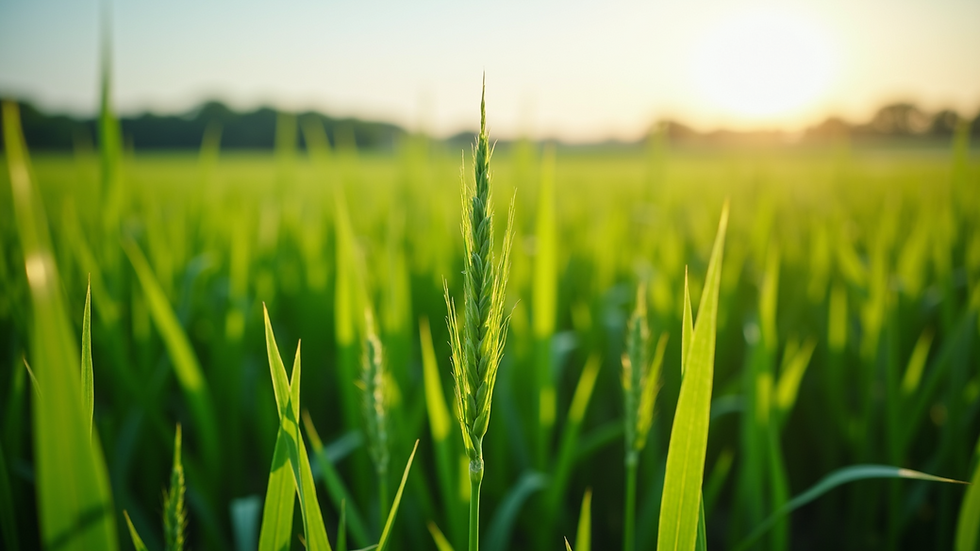How Regenerative Agriculture Benefits Your Health and Environment
- Jul 21
- 4 min read
Regenerative agriculture is more than just a farming method; it is a holistic approach that can transform our health and the environment. As we face challenges like climate change, soil degradation, and food insecurity, regenerative practices offer a promising solution. This blog post will explore how regenerative agriculture benefits both our health and the environment, providing practical insights and examples along the way.
What is Regenerative Agriculture?
Regenerative agriculture focuses on restoring and enhancing the health of the soil, ecosystems, and communities. Unlike conventional farming, which often depletes resources, regenerative practices aim to improve soil fertility, increase biodiversity, and promote sustainable land use.
Key principles of regenerative agriculture include:
Soil Health: Building healthy soil through composting, cover cropping, and reduced tillage.
Biodiversity: Encouraging a variety of plants and animals to create a balanced ecosystem.
Water Management: Using techniques that enhance water retention and reduce runoff.
Community Engagement: Involving local communities in decision-making and promoting fair labor practices.
These principles not only help the environment but also contribute to healthier food systems.
Health Benefits of Regenerative Agriculture
Nutrient-Rich Food
One of the most significant benefits of regenerative agriculture is the production of nutrient-dense food. Healthy soil leads to healthier crops. When farmers use regenerative practices, they often see an increase in the nutritional value of their produce.
For example, studies have shown that vegetables grown in nutrient-rich soil contain higher levels of vitamins and minerals. This means that when you choose food from regenerative farms, you are likely consuming more nutrients, which can lead to better overall health.
Reduced Chemical Exposure
Conventional farming often relies on synthetic fertilizers and pesticides, which can leave harmful residues on food. Regenerative agriculture, on the other hand, minimizes or eliminates the use of these chemicals.
By choosing regenerative products, you reduce your exposure to harmful substances. This is especially important for vulnerable populations, such as children and pregnant women, who may be more sensitive to chemical exposure.
Improved Gut Health
The connection between gut health and overall well-being is becoming increasingly clear. A diet rich in diverse, whole foods can promote a healthy gut microbiome. Regenerative agriculture supports biodiversity, which means a wider variety of fruits, vegetables, and grains are available.
Eating a diverse diet can help maintain a balanced gut microbiome, leading to improved digestion, better immune function, and even enhanced mood.
Environmental Benefits of Regenerative Agriculture
Soil Restoration
Healthy soil is the foundation of a thriving ecosystem. Regenerative agriculture focuses on rebuilding soil health through practices like cover cropping and reduced tillage.
These methods help to:
Increase organic matter in the soil, which improves its structure and fertility.
Enhance water retention, reducing the need for irrigation.
Sequester carbon, helping to mitigate climate change.
By restoring soil health, regenerative agriculture can combat erosion and promote sustainable land use.
Biodiversity Enhancement
Biodiversity is crucial for a resilient ecosystem. Regenerative agriculture encourages a variety of plants and animals, which can lead to a more balanced environment.
For instance, integrating livestock into crop production can help control pests naturally, reducing the need for chemical pesticides. Additionally, diverse plant species can attract beneficial insects, which further supports ecosystem health.
Water Conservation
Water scarcity is a growing concern in many regions. Regenerative agriculture employs techniques that enhance water retention in the soil, reducing runoff and conserving water resources.
Practices such as mulching, cover cropping, and agroforestry can significantly improve water management. This not only benefits farmers but also helps to maintain local water supplies for communities.
Real-World Examples of Regenerative Agriculture
Polyface Farm
Located in Virginia, Polyface Farm is a well-known example of regenerative agriculture in action. The farm uses rotational grazing, which allows livestock to graze on different pastures while giving the land time to recover.
This method improves soil health, increases biodiversity, and produces high-quality meat and dairy products. Customers rave about the taste and nutritional value of the food, showcasing the benefits of regenerative practices.
Rodale Institute
The Rodale Institute in Pennsylvania is a pioneer in regenerative agriculture research. They have conducted long-term studies comparing conventional and regenerative farming methods.
Their findings show that regenerative practices lead to healthier soil, increased crop yields, and reduced reliance on chemical inputs. The institute also offers educational programs to help farmers transition to regenerative methods.
How You Can Support Regenerative Agriculture
Choose Local and Organic
One of the easiest ways to support regenerative agriculture is by choosing local and organic products. Look for farmers' markets or community-supported agriculture (CSA) programs in your area.
By purchasing directly from farmers who practice regenerative methods, you not only support their work but also enjoy fresher, more nutritious food.
Educate Yourself and Others
Knowledge is power. Take the time to learn about regenerative agriculture and its benefits. Share this information with friends and family to raise awareness about the importance of sustainable farming practices.
Advocate for Policy Change
Support policies that promote regenerative agriculture at local, state, and national levels. This can include advocating for funding for sustainable farming programs or supporting legislation that encourages soil health initiatives.
The Future of Food and Farming
As we look to the future, regenerative agriculture offers a hopeful path forward. By prioritizing soil health, biodiversity, and community engagement, we can create a food system that benefits both people and the planet.
The shift towards regenerative practices is not just a trend; it is a necessary evolution in how we approach food production. As consumers, we have the power to drive this change by making informed choices and supporting sustainable practices.

In a world facing environmental challenges, regenerative agriculture stands out as a beacon of hope. By embracing these practices, we can improve our health, protect our environment, and create a more sustainable future for generations to come.
Let us take action today, supporting regenerative agriculture and reaping the benefits for ourselves and the planet. Together, we can cultivate a healthier world.





Comments